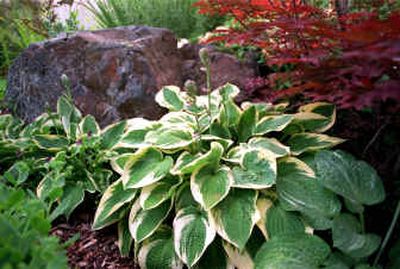Made in the shade

“… Gardens are not made by singing, ‘Oh aren’t they beautiful’ and sitting in the shade,” author Rudyard Kipling warns in his poem “The Glory of the Garden.” While sitting won’t get your garden planted, the shade might be exactly where you should be headed for your next landscaping project.
Gardening expert Betty Lou Sandy says shade gardening and its aesthetic potential are “very underestimated.” Sandy, a private gardening consultant and teacher who lives in Manchester, Conn., says it’s lack of vision rather than reality that discourages people from looking to the shady areas of their yard to establish a garden oasis.
“It’s usually a case of not knowing enough about the kinds of plants that are suitable for a shady area,” Sandy says. “And people think that a shade garden means just limited, green plants. They don’t realize that a shade garden can have color from March to October.” Critical to a successful shade garden is an understanding of what kind of shade the area in your yard has at different times of the day and different seasons of the year.
“Take a good look at your yard and determine the shade pattern,” says Massachusetts arborist Russ Bragg, who turned a heavily shaded yard into a business called Underwood Shade Nursery.
Dense shade, which means the area looks like a very dense forest; light shade, which has streams of shifting sunlight; half shade, half sun, places with four to five hours of sun and shade; and “sky shine” light but no sun are the categories often used to identify shaded areas.
“How much light, how much sun, whether you have deciduous trees or evergreens, all help determine what you can plant in a shade garden,” Sandy says.
The seasons can work for you; for example, in early spring, perhaps the area under a tree that’s shady later in the season is getting some light.
“There is no reason why bulbs can’t be planted under a deciduous tree. The leaves aren’t out so the bulbs will get more than enough light and sun for spring blooming. That is color that can start the season,” Sandy says.
From then on, it’s a matter of choosing from among the many plants that will not only survive, but flourish, especially when the flowers in the sun gardens are flailing because of the oppressive summer heat.
Except for very dense shade, where plants such as ferns and hostas are happiest, the possibilities are myriad for the shade garden. Perennials, including primrose, bleeding hearts, astilbes, hydrangeas, mountain laurels and asters, provide structure and color from April to November. For quick hits of colors, annuals such as impatiens, begonias, iris, geraniums and pansies will do well in a shady area, Sandy says.
Bragg suggests dozens of others, including more contemporary choices such as the Canada mayflower, partridgeberry and hellebores, including “Lenten Rose,” which was awarded the 2004 Klein Plant Award by the American Horticultural Society.
Trumpet vines and climbing hydrangeas also do well in shade and can add additional interest to the garden if planted near a fence or arbor.